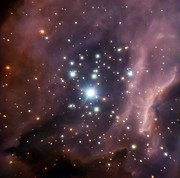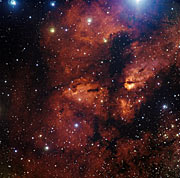Press Release
A Look into the Hellish Cradles of Suns and Solar Systems
19 August 2009
New images released today by ESO delve into the heart of a cosmic cloud, called RCW 38, crowded with budding stars and planetary systems. There, young stars bombard fledgling suns and planets with powerful winds and blazing light, helped in their task by short-lived, massive stars that explode as supernovae. In some cases, this onslaught cooks away the matter that may eventually form new solar systems. Scientists think that our own Solar System emerged from such an environment.
The dense star cluster RCW 38 glistens about 5500 light years away in the direction of the constellation Vela (the Sails). Like the Orion Nebula Cluster, RCW 38 is an “embedded cluster”, in that the nascent cloud of dust and gas still envelops its stars. Astronomers have determined that most stars, including the low mass, reddish ones that outnumber all others in the Universe, originate in these matter-rich locations. Accordingly, embedded clusters provide scientists with a living laboratory in which to explore the mechanisms of star and planetary formation.
“By looking at star clusters like RCW 38, we can learn a great deal about the origins of our Solar System and others, as well as those stars and planets that have yet to come”, says Kim DeRose, first author of the new study that appears in the Astronomical Journal. DeRose did her work on RCW 38 as an undergraduate student at the Harvard-Smithsonian Center for Astrophysics, USA.
Using the NACO adaptive optics instrument on ESO’s Very Large Telescope [1], astronomers have obtained the sharpest image yet of RCW 38. They focused on a small area in the centre of the cluster that surrounds the massive star IRS2, which glows in the searing, white-blue range, the hottest surface colour and temperatures possible for stars. These dramatic observations revealed that IRS2 is actually not one, but two stars — a binary system consisting of twin scorching stars, separated by about 500 times the Earth–Sun distance.
In the NACO image, the astronomers found a handful of protostars — the faintly luminous precursors to fully realised stars — and dozens of other candidate stars that have eked out an existence here despite the powerful ultraviolet light radiated by IRS2. Some of these gestating stars may, however, not get past the protostar stage. IRS2’s strong radiation energises and disperses the material that might otherwise collapse into new stars, or that has settled into so-called protoplanetary discs around developing stars. In the course of several million years, the surviving discs may give rise to the planets, moons and comets that make up planetary systems like our own.
As if intense ultraviolet rays were not enough, crowded stellar nurseries like RCW 38 also subject their brood to frequent supernovae when giant stars explode at the ends of their lives. These explosions scatter material throughout nearby space, including rare isotopes — exotic forms of chemical elements that are created in these dying stars. This ejected material ends up in the next generation of stars that form nearby. Because these isotopes have been detected in our Sun, scientists have concluded that the Sun formed in a cluster like RCW 38, rather than in a more rural portion of the Milky Way.
“Overall, the details of astronomical objects that adaptive optics reveals are critical in understanding how new stars and planets form in complex, chaotic regions like RCW 38”, says co-author Dieter Nürnberger.
Notes
[1] The name “NACO” is a combination of the Nasmyth Adaptive Optics System (NAOS) and the Near-Infrared Imager and Spectrograph (CONICA). Adaptive optics cancels out most of the image-distorting turbulence in Earth’s atmosphere caused by temperature variations and wind.
More information
This research was presented in a paper that appeared in the Astronomical Journal: A Very Large Telescope / NACO study of star formation in the massive embedded cluster RCW 38, by DeRose et al. (2009, AJ, 138, 33-45).
The team is composed of K.L. DeRose, T.L. Bourke, R.A. Gutermuth and S.J. Wolk (Harvard-Smithsonian Center for Astrophysics, Cambridge, USA), S.T. Megeath (Department of Physics and Astronomy, The University of Toledo, USA), J. Alves (Centro Astronómico Hispano Alemán, Almeria, Spain), and D. Nürnberger (ESO).
ESO, the European Southern Observatory, is the foremost intergovernmental astronomy organisation in Europe and the world’s most productive astronomical observatory. It is supported by 14 countries: Austria, Belgium, Czechia, Denmark, France, Finland, Germany, Italy, the Netherlands, Portugal, Spain, Sweden, Switzerland and the United Kingdom. ESO carries out an ambitious programme focused on the design, construction and operation of powerful ground-based observing facilities enabling astronomers to make important scientific discoveries. ESO also plays a leading role in promoting and organising cooperation in astronomical research. ESO operates three unique world-class observing sites in Chile: La Silla, Paranal and Chajnantor. At Paranal, ESO operates the Very Large Telescope, the world’s most advanced visible-light astronomical observatory. ESO is the European partner of a revolutionary astronomical telescope ALMA, the largest astronomical project in existence. ESO is currently planning a 42-metre European Extremely Large optical/near-infrared Telescope, the E-ELT, which will become “the world’s biggest eye on the sky”.
Links
- Science paper: http://arxiv.org/abs/0904.3279 or http://www.iop.org/EJ/abstract/1538-3881/138/1/33/
- Adaptive optics page
- VLT page
Contacts
Dieter Nürnberger
ESO
Chile
Tel: +56 2 463 3080
Email: dnuernbe@eso.org
About the Release
| Release No.: | eso0929 |
| Legacy ID: | PR 29/09 |
| Name: | RCW 38 |
| Type: | Milky Way : Star : Grouping : Cluster |
| Facility: | Very Large Telescope |
| Instruments: | NACO |
| Science data: | 2009AJ....138...33D |
Our use of Cookies
We use cookies that are essential for accessing our websites and using our services. We also use cookies to analyse, measure and improve our websites’ performance, to enable content sharing via social media and to display media content hosted on third-party platforms.
ESO Cookies Policy
The European Organisation for Astronomical Research in the Southern Hemisphere (ESO) is the pre-eminent intergovernmental science and technology organisation in astronomy. It carries out an ambitious programme focused on the design, construction and operation of powerful ground-based observing facilities for astronomy.
This Cookies Policy is intended to provide clarity by outlining the cookies used on the ESO public websites, their functions, the options you have for controlling them, and the ways you can contact us for additional details.
What are cookies?
Cookies are small pieces of data stored on your device by websites you visit. They serve various purposes, such as remembering login credentials and preferences and enhance your browsing experience.
Categories of cookies we use
Essential cookies (always active): These cookies are strictly necessary for the proper functioning of our website. Without these cookies, the website cannot operate correctly, and certain services, such as logging in or accessing secure areas, may not be available; because they are essential for the website’s operation, they cannot be disabled.
Functional Cookies: These cookies enhance your browsing experience by enabling additional features and personalization, such as remembering your preferences and settings. While not strictly necessary for the website to function, they improve usability and convenience; these cookies are only placed if you provide your consent.
Analytics cookies: These cookies collect information about how visitors interact with our website, such as which pages are visited most often and how users navigate the site. This data helps us improve website performance, optimize content, and enhance the user experience; these cookies are only placed if you provide your consent. We use the following analytics cookies.
Matomo Cookies:
This website uses Matomo (formerly Piwik), an open source software which enables the statistical analysis of website visits. Matomo uses cookies (text files) which are saved on your computer and which allow us to analyze how you use our website. The website user information generated by the cookies will only be saved on the servers of our IT Department. We use this information to analyze www.eso.org visits and to prepare reports on website activities. These data will not be disclosed to third parties.
On behalf of ESO, Matomo will use this information for the purpose of evaluating your use of the website, compiling reports on website activity and providing other services relating to website activity and internet usage.
Matomo cookies settings:
Additional Third-party cookies on ESO websites: some of our pages display content from external providers, e.g. YouTube.
Such third-party services are outside of ESO control and may, at any time, change their terms of service, use of cookies, etc.
YouTube: Some videos on the ESO website are embedded from ESO’s official YouTube channel. We have enabled YouTube’s privacy-enhanced mode, meaning that no cookies are set unless the user actively clicks on the video to play it. Additionally, in this mode, YouTube does not store any personally identifiable cookie data for embedded video playbacks. For more details, please refer to YouTube’s embedding videos information page.
Cookies can also be classified based on the following elements.
Regarding the domain, there are:
- First-party cookies, set by the website you are currently visiting. They are stored by the same domain that you are browsing and are used to enhance your experience on that site;
- Third-party cookies, set by a domain other than the one you are currently visiting.
As for their duration, cookies can be:
- Browser-session cookies, which are deleted when the user closes the browser;
- Stored cookies, which stay on the user's device for a predetermined period of time.
How to manage cookies
Cookie settings: You can modify your cookie choices for the ESO webpages at any time by clicking on the link Cookie settings at the bottom of any page.
In your browser: If you wish to delete cookies or instruct your browser to delete or block cookies by default, please visit the help pages of your browser:
Please be aware that if you delete or decline cookies, certain functionalities of our website may be not be available and your browsing experience may be affected.
You can set most browsers to prevent any cookies being placed on your device, but you may then have to manually adjust some preferences every time you visit a site/page. And some services and functionalities may not work properly at all (e.g. profile logging-in, shop check out).
Updates to the ESO Cookies Policy
The ESO Cookies Policy may be subject to future updates, which will be made available on this page.
Additional information
For any queries related to cookies, please contact: pdprATesoDOTorg.
As ESO public webpages are managed by our Department of Communication, your questions will be dealt with the support of the said Department.





